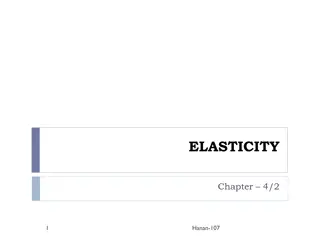Triple Challenges of Jobs: Quality, Quantity, and Inclusiveness Conference Insights
The Capital Hotel in Addis Ababa hosted the Jobs and Development Conference on February 22, 2023. Tigabu Degu, the Lead Researcher, discussed the triple challenges of jobs - focusing on the issues of quantity, quality, and inclusiveness in the labor market. The conference highlighted the high unemployment rate, rapid labor force growth, lack of job creation, poor job quality, and inclusivity concerns in the African labor markets, particularly in Ethiopia. It emphasized the need to address these challenges for sustainable development.
Download Presentation

Please find below an Image/Link to download the presentation.
The content on the website is provided AS IS for your information and personal use only. It may not be sold, licensed, or shared on other websites without obtaining consent from the author.If you encounter any issues during the download, it is possible that the publisher has removed the file from their server.
You are allowed to download the files provided on this website for personal or commercial use, subject to the condition that they are used lawfully. All files are the property of their respective owners.
The content on the website is provided AS IS for your information and personal use only. It may not be sold, licensed, or shared on other websites without obtaining consent from the author.
E N D
Presentation Transcript
Triple Challenges of Jobs: Quality ,Quantity and Inclusiveness Tigabu Degu, Lead Researcher Capital Hotel , Addis Ababa Jobs and Development Conference February 22,2023 1
Triple challenges of Jobs 1. Quantity: Unemployment rate is high In SSA/Ethiopia and Jobless is a more pressing issue in Ethiopia the country is the second most populous in Africa, producing over 150,000 graduates each year but less education to work transformation Rapid LF Growth :TLF has increased from <15M in 1984 to 30M in 2007 to >44M in 2013 and to 60M in 2021 (MoLSA, 2021)
Labor force growth The country s labor force has been substantially increasing. But less than 5 % additional jobs over last decade created and Less than 78% of the LF participated in the LM. Still more than two-third of the LFP are engaged in the seasonal & low paying farming (WB, 2018). Labor force 53 51 50 60 48 47 LF size (millions) 39 40 28 20 20 - 1990 2000 2010 2015 2016 Year 2017 2018 2019 Source: World Bank data website 3
Triple challenges of Jobs 2. Quality : Job quality refers to remuneration, contractual arrangements, prospect to carrier and skill development , occupational safety and health, working conditions and hours, industrial relations, The poor-quality employment is even a more severe labor market challenge in SSA compared to the unemployment problem Distinct features of the African labor markets: informality, underemployment , low labor productivity, low wage and high levels of working poverty (See Fields, 2019; ILO, 2019). high turnover in the manufacturing sector because of low wages and rigid and unhealthy working conditions. 40 77% of the workers leave the firms annually (Abebe et al., 2019; Blattman and Dercon, 2018). lack of quality job opportunities in SSA is a key factors that play a role in a person s decision to migrate(ibid)
Triple challenges of Jobs 3. Inclusiveness : The problem is even worse for women and youth Inclusiveness of employment refers to granting equal opportunities for employees at the workplace, irrespective of their gender, age, race, disability status, etc. Creating more , better and inclusive jobs is an integral part of the Goal 8 of the 2030 Agenda for Sustainable Development.
Objective 1.Identify the determinants of the quality and quantity of Jobs : Tigabu 2.Investigate the relationship between job quality and firm productivity 3.Evaluate the wellbeing and gender effect of quality jobs : Gebeyehu 4.Examine the net job effects (direct, indirect, induced and substitution) of the agro industries
The Determinants of Job Quality and Quantity: Evidence from the Ethiopia Leather and Agro-Processing Sector
Objective What types of firms (size, sector, ownership etc) are creating better and more jobs? What determine the firms potential to create more and better jobs ? Is there a trade off between increasing quality and quantity of Jobs? Is better quality jobs achieve at the cost of more Jobs?
Quality vs. Quantity Low wages and high labor turnover may create a vicious circle of low quality and low productivity sector. Low wage >>> low motivation & high turnover >>> less incentive to invest on human capital >>> low productivity >>> low wage However, there have been also a concern that improving the quality of jobs implies important costs to firms, Hence, the relation ship between job quality and quantity is an empirical question The marginal cost /MPL ratio matters !!!
Data and sampling The study uses a panel data of 400 firms in the agro- processing and leather sectors in Ethiopia Sampling frame : administrative enterprise list obtained from the Leather Industry Development Institute (LIDI), the Food, Beverage and Pharmaceutical Industry Development Institute and the Ministry of Industry We conducted the baseline survey of 460 firms in 2017 We traced and conduct a follow-up survey of the 400 firms in 2020. Main reason for attrition: 32 firms were closed and 24 firms change location and few others refused 10
Measurements : Job Quantity and Quality we use different measures of job quantity Measures of job quantity The total number of workers in at the survey years Hired-quite-dismissed-contract ended during12 months prior to survey Percentage change in number of employees between survey rounds and between year of firm establishment and survey rounds. Expected number of workers to be hired in the coming 12 months Total cost of labor divided by the total investment on machines and equipment Share of imported inputs Percent of imported inputs the firms used for production; to measure indirect Job creation Total number of workers Net job/employment created Cumulative and annual employment growth Expected number of job creation L/K 11
Job Quality 1. (1) availability of formal grievance handling procedure, (2) in house training for production workers (3) formal training, (4) OSH policy, (5) OSH awareness, (6) whether workers represented in the decision-making committee, (7) accident recording, (8) availability of washing facilities, and (9) whether wage rate is higher than the median wage rate 1. Singular indicators Entry level average salary disaggregate by skill of Workers Current salary disaggregated by skill and tenure (remuneration) Share of permanent workers disaggregated by skill (job security) Prospect for career development :percentage of workers who attend in house and formal training organized by the firm) Written OSH policy and written grievance and dispute handling mechanism Over time rate and working condition Composite Job quality Index :using nine job quality indicators 12
Descriptive results At start up, around 29% of the firms were micro, 49% were small, 19% were medium and the remaining 7% were large in size. In the survey year around 8 % were micro, 45 % were small, 24 % were medium and around 24 % were large in size, indicating overall growth in size On average, micro firms were the youngest (17 years old), followed by small firms (21 years old), medium sized firms (22 years old) while large firms were the oldest (33 years old) We disaggregate analysis by nationality of owners, sector type and size 13
Nationality and Job quantity Indicators Ownership nationality Foreign Ethiopian Mean owner owner difference Mean Mean Mean Job quantity indicators Employment growth 982 376. 607** Net job created, last 12 months 8 2 6* Average number of workers 450 80 370*** Expected number of employment 79 13 66*** Share of low skill production workers 42 38 4 Labor to capital ratio 26 294 -268* Share of imported inputs used 22.6 6.0 17*** 14
Quantity of Jobs by owner nationality Cumulative job creation/employment growth at foreign owned firms is three times hire than that of domestic firms Net job created 12 months prior to the survey rounds is four times higher for foreign firms compared to domestic firms (8% Vs 2%) On average the foreign owned firms hired 450 workers while the domestic firms hired only 79 workers during the survey years. However, Foreign owned firms used larger percentage of imported inputs than their domestic counterpart (23% vs6%) , which suggests that foreign firms create relatively less indirect jobs than domestically owned firms. L/K ratio is lower for foreign owned firms than domestic owned firms (foreign firms use labor saving technology) 15
Job quality disaggregated by Nationality A relatively larger percentage of foreign owned firms compared to domestic firms have provide in household and formal trainings for their workers, have written OSH policies, Have grievance handling and dispute resolution mechanism, keep records of work-related accidents and diseases, and pay higher Over time rate for hours worked beyond standard working hours. However, there is no statistically significant wage difference between foreign and domestically owned firms. 16
Quantity of Jobs by sector Indicators Sector type Leather Agro- Mean processing differen ce Mean Mean Mean Cumulative Employment growth 577. 289 288** Net job, last 12 months 4 2 2 Total number of workers 125 84 41* Expected number of workers 17 15 -2 Share of low skill production 46 31 15*** workers share of high skill production 21 33 -12*** workers Labor to capital ratio 205 333 -268* share of imported inputs used 7 7 0.2 17
Quantity of Jobs by sector cumulative employment growth rate was twice higher for leather firms than agro-processing firms Leather firms employed also higher number of total workers, production workers at the time of survey Net job creation /net employment 12 months prior to survey was also higher at leather firms than agro-processing firm. In terms of quality of Jobs leather firms provide better quality jobs than agro- processing firms do However, the Leather sector mainly created job for low skill workers than agro-processing firms The leather sector use less labor intensive technology than agro-processing Similarly, overall, leather firms provide better quality jobs than agro-processing firms do 18
Econometrics Analysis We used different econometric models since we have different measures of the dependent variables. 1. Panel linear models (OLS,MCPFE) employment growth, net employment, number of workers and wage 2. Correlated random effects Ordered Logit model: Job quality index 3. Correlated random-effects Probit model: Ever send production workers to formal training, the firm has written OSH policy, The firm has formal written grievance handling and dispute resolution mechanism 4. Fractional correlated random-effects Probit model: share of Permanent production workers by skill categories 5. Correlated Random effects Tobit models: percent of imported input used by firm We exploited the panel nature of our data to control for time-invariant unobserved firm-level fixed effects using the Mundlak-Chamberlain pseudo fixed effects (MCPFE). We use MCPFE instead of pure FE since manager and owner characteristics, do not change overtime. 19
Econometric results Determinants of job quantity A number of factors affect job quantity. Firm age: Employment (total labor) increases by around 1% as age of the firms increase by one year. The result is consistent to the literature (Block et al., 2018; van Praag and Versloot, 2007) Firms located inside the industrial parks employed around 1.01 more workers in the last 12 months, created 17% higher total employment (jobs), and they expected to employ around 35% more workers than firms located outside industrial parks; perhaps, because of positive externalities (i.e., localization effect). Firms which actively engage with customers through advertising and by establishing websites create higher quantity of jobs as measured by net employment and total employment. Similar to (Levesque et al., 2015). Leather producing firms create around 37% larger number of jobs and expect to create around 51% higher lobs within 12 months than agro- processing firms 20
Determinants of job quantity Covariates OLS Correlated random effects Tobit model Percent of imported inputs Mundlak-Chamberlin pseudo fixed effects, linear Employment growth Net Total labor (ln) Labor to capital ratio (ln) Expected No. of workers to be hired (IHS) 0.00 (0.00) 0.30*** (0.06) 0.16+ (0.08) 0.19 (0.29) 0.18 (0.16) 0.45** (0.16) 0.41*** (0.05) employment Firm's age, years 15.27* (6.11) 122.06 (132.74) 303.94 (199.12) 176.27 (134.78) 265.64 (217.00) 306.00 (210.56) -110.99 (125.65) -0.04 (0.13) 1.01+ (0.61) -0.69 (2.23) 3.59* (1.43) 2.01* (0.94) 3.13 (1.93) 0.01 (0.65) 0.01*** (0.00) 0.17*** (0.03) 0.28* (0.13) 0.23*** (0.06) 0.28*** (0.01) 0.23*** (0.00) 0.03 (0.14) -5.30+ (3.09) -250.09*** (73.50) -181.86*** (27.47) -240.67 (219.78) 273.14 (186.85) 17.42 (16.43) -77.87 (269.75) 0.40 (0.30) -12.40 (9.39) 7.59 (9.61) 8.85 (9.16) 24.83** (9.29) -33.10* (14.43) 16.00+ (9.41) The firm is located inside the Industrial Parks The firm is currently exporting The firm advertises The firm has website Ownership status changed since establishment Leather firm (1/0) Firm size at establishment: base variable micro Small -121.63 (91.52) -863.89*** (164.72) -1475.94*** (231.73) Yes 0.95 (0.82) 3.03 (2.20) -7.93** (2.49) Yes Yes 0.26+ (0.14) 0.66*** (0.17) 0.72** (0.27) Yes Yes 102.96*** (18.62) -3.54 (43.83) -80.69 (106.99) Yes Yes 0.12 (0.24) 0.42* (0.21) 0.56 (0.45) Yes Yes -14.00 (10.29) -6.76 (14.13) -8.73 (15.79) Yes Yes Medium Large Business ownership Survey year (2020) Fixed effects City fixed effects Mundlak fixed effects Yes 487.27 (809.70) 381 0.51 Yes Yes Yes Yes Yes Yes Yes Yes Yes Yes Constant 10.03*** (0.13) 780 0.08 0.88 (0.58) 745 0.82 -1019.39 (1244.81) 739 0.05 0.41 (1.57) 781 0.23 -60.40 (59.58) 789 Observations R-square Overall correlation 21
Determinants of job quality Experience or firm age. For instance, monthly salary of medium and high skilled workers with one year tenure at the firms increases by about 0.1% and 0.2% with age of firms statistically significantly. Firms located inside the industrial parks pay around 7% lower salaries for low and medium skill workers with one year tenure, and around 6% lower entry-level salaries than firms located outside industrial parks. We found that exporting firms pay around 4.5% lower entry-level salaries for low skill workers than non-exporting firms. Firms which have websites and which advertise pay higher salaries. Overall, salaries and firm size are inversely related. Foreign owned firms and share companies pay less salaries than domestic PLCs. 22
Determinants of job quality Covariates Average job-entry (starting) monthly salary for production workers (ln) Average monthly salary for production workers with one year tenure (ln) Low skill skill Low skill Medium High skill Medium skill 0.002** (0.001) -0.055 (0.035) High skill Firm's age, years 0.002** (0.001) -0.061** (0.026) 0.002 (0.002) 0.044 (0.030) 0.001 (0.001) - 0.073*** (0.022) -0.039 (0.044) 0.019 (0.026) 0.108*** (0.012) 0.048** (0.020) 0.038*** (0.010) -0.025 (0.019) 0.001*** (0.000) -0.070** (0.034) 0.002** (0.001) 0.023 (0.030) The firm located inside the Industrial Parks The firm is currently exporting -0.045* (0.026) 0.037* (0.020) 0.057*** (0.010) 0.050* (0.027) 0.044*** (0.016) -0.022 (0.022) -0.049 (0.090) 0.070** (0.030) 0.122** (0.058) 0.059*** (0.005) 0.070*** (0.016) -0.013 (0.079) -0.021 (0.077) 0.059* (0.034) 0.157 (0.140) 0.028 (0.088) 0.162** (0.069) -0.135*** (0.030) -0.084 (0.075) 0.116*** (0.029) 0.124* (0.065) 0.025*** (0.007) 0.067*** (0.024) 0.006 (0.058) -0.045 (0.120) 0.075*** (0.023) 0.142 (0.087) 0.051 (0.045) 0.153** (0.064) -0.106* (0.057) The firm advertises The firm has website There are workers who are members of trade unions Ownership status changed since establishment Leather firm (1/0) Firms size - Base variable: micro Small 0.032 (0.083) -0.066 (0.050) -0.203** (0.088) -0.003 (0.007) Yes -0.232*** (0.081) Yes Yes Yes Yes Yes 6.658*** (0.169) 780 0.253 0.055 (0.084) 0.015 (0.064) -0.125 (0.110) 0.003 (0.010) Yes -0.086 (0.089) Yes Yes Yes Yes Yes 6.768*** (0.438) 780 0.286 -0.005 (0.017) -0.08*** (0.010) -0.137*** (0.003) 0.038 (0.026) Yes -0.000 (0.032) Yes Yes Yes Yes Yes 6.878*** (0.878) 780 0.272 0.009 (0.085) -0.068* (0.039) -0.180** (0.085) -0.006 (0.008) Yes -0.196** (0.081) Yes Yes Yes Yes Yes 6.711*** (0.168) 780 0.239 0.045 (0.067) 0.049*** (0.019) -0.055 (0.075) 0.004 (0.014) Yes -0.091 (0.100) Yes Yes Yes Yes Yes 6.771*** (0.302) 780 0.278 0.024 (0.045) -0.009 (0.086) -0.079 (0.067) 0.040 (0.026) Yes -0.064 (0.057) Yes Yes Yes Yes Yes 6.829*** (0.792) 780 0.283 Medium Large Job quality index, excluding wage Ownership type Ethiopian manager Manager characteristics Worker characteristics Survey year dummy (2018) City fixed effects Fixed effects Constant Observations Overall correlation 23
Determinants of job quality Covariates Correlated random effects Ordered Logit model Job quality index Correlated random effects Probit model Ever send production workers to formal training Provided training to production workers in the last 3 years -0.000 (0.002) 0.315*** (0.091) The firm has written OSH policy The firm has formal written grievance handling and dispute resolution mechanism 0.005 (0.009) 0.200*** (0.042) Firm's age, years 0.004 (0.004) 0.285*** (0.020) 0.005 (0.007) 0.038 (0.121) 0.002 (0.006) -0.072 (0.086) The firm located inside the Industrial Parks The firm is currently exporting The firm advertises 0.300*** (0.063) 0.563*** (0.005) 0.849** (0.365) 0.717** (0.304) -0.111*** (0.031) 0.388** (0.189) 0.431 (0.321) 0.492*** (0.148) 0.270 (0.238) 0.246*** (0.027) 0.423* (0.230) 0.008 (0.308) 0.116 (0.193) 0.049 (0.189) 0.323*** (0.026) -0.036 (0.156) 0.216*** (0.061) 0.350*** (0.073) 0.291*** (0.022) 0.484*** (0.172) The firm has website There are workers who are members of trade unions Leather firm (1/0) 0.116 (0.113) 0.083 (0.065) 0.388** (0.194) -0.372* (0.203) 0.188*** (0.066) 0.200 (0.169) -0.465*** (0.094) 0.100 (0.148) -0.245 (0.287) -0.076 (0.551) Ownership status changed since establishment Firms size - Base variable: micro Small 0.303* (0.158) 0.741*** (0.166) 1.085*** (0.370) Yes Yes Yes Yes Yes 800 0.082 (0.531) -0.130 (0.458) -0.023 (0.346) Yes Yes Yes Yes Yes -3.394* (2.018) 775 -0.121 (0.191) 0.211 (0.540) 0.008 (0.786) Yes Yes Yes Yes Yes -2.162*** (0.612) 791 -0.108 (0.313) 0.072 (0.139) 0.810*** (0.275) Yes Yes Yes Yes Yes -2.097 (1.896) 786 0.091 (0.218) 0.496** (0.240) 0.723*** (0.231) Yes Yes Yes Yes Yes -2.577*** (0.678) 786 Medium Large Manager characteristic Worker characteristic Survey year City fixed effects fixed effects Constant Observations 24
Correlation b/n job quality and quantity Finally, we investigate if there is tradeoff or complementarity between job quantity and job quality, which has been overlooked in the literature. The results show that the higher is job quality index, the higher are the employment size (i.e., total labor) and the number of workers the firms expect to hire in the near future. On the other hand, the higher the daily wage rate, the less the number of workers the firms expect to hire in the near future. 25
Correlation b/n job quality and quantity Covariates Job quantity indicators Net employment in the last 12 months Job quality indicators Monthly salary for medium skill production workers with one year tenure (ln) Employment growth between 2014 and 2017 Total labor (ln) Labor to capital total cost ratio (ln) Expected number of workers to be hired in the coming 12 months Monthly salary for low skill production workers with one year tenure (ln) Monthly salary for high skill production workers with one year tenure (ln) Job quality index Job quality index 0.411 (0.329) 0.228 (1.525) -0.155 (0.789) -1.069 (1.760) 0.100*** (0.013) -0.017 (0.035) -0.024 (0.111) 0.110 (0.084) 5.441*** (1.273) -3.575*** (0.445) Daily average earning of production workers (ln) Employment growth between 2014 and 2017 Net employment in the last 12 months Firm characteristics Owner characteristics Worker characteristics City effects Mundlak fixed effects Constant -0.000 (0.000) -0.000 (0.000) 0.000*** (0.000) -0.000 (0.001) 0.000 (0.001) Yes Yes -0.000 (0.001) Yes Yes -0.000 (0.000) Yes Yes -0.001 (0.004) Yes Yes Yes Yes Yes Yes Yes Yes Yes Yes Yes Yes Yes Yes Yes Yes Yes Yes Yes Yes Yes Yes Yes Yes Yes Yes Yes Yes Yes Yes Yes Yes Yes Yes 57.801** (21.587) 781 0.076 4.579*** (0.618) 778 0.087 1.016* (0.530) 745 0.830 -0.460 (2.715) 540 0.152 34.154*** (7.261) 779 0.228 6.681*** (0.075) 780 0.233 6.715*** (0.193) 780 0.283 6.750*** (0.846) 780 0.278 Observations r2 Overall correlation 780 26
Correlation between Job Quantity and Quality Positive correlation b/n Job quality (training, OSH,OT) and quantity(Em pG) 27
4. Results: descriptive Correlation b/n job quality and quantity. Positive correlation b/n Job quality and quantity 28
5. Conclusion We found that large firms pay lower wage rates than small firms for low skill workers; however, non-wage qualities of job improve with the size of the firms. We found that foreign owned firms employ relatively larger number of workers, and they grow faster in terms of employment size than domestically owned firms. However, they mainly depend on imported inputs, creating less indirect jobs than domestic firms do Employment growth is inversely related with firm size at establishment. However, the employment growth rate of small firms is insufficient to catch up with the employment size of initially large firms even after 21 average years of operation. Our results show that, overall, there is no trade off between job quantity and job quality; rather, there is, majorly, complementarity between the two after controlling for firm, manager and worker characteristics. 29























